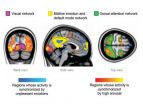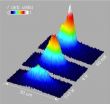(Press-News.org) Research from Karolinska Institutet in Sweden shows that the human olfactory bulb – a structure in the brain that processes sensory input from the nose – differs from that of other mammals in that no new neurons are formed in this area after birth. The discovery, which is published in the scientific journal Neuron, is based on the age-determination of the cells using the carbon-14 method, and might explain why the human sense of smell is normally much worse than that of other animals.
"I've never been so astonished by a scientific discovery," says lead investigator Jonas Frisén, Tobias Foundation Professor of stem cell research at Karolinska Institutet. "What you would normally expect is for humans to be like other animals, particularly apes, in this respect."
It was long thought that all brain neurons were formed up to the time of birth, after which production stopped. A paradigm shift occurred when scientists found that nerve cells were being continually formed from stem cells in the mammalian brain, which changed scientific views on the plasticity of the brain and raised hopes of being able to replace neurons lost during some types of neurological disease.
In the adult mammal, new nerve cells are formed in two regions of the brain: the hippocampus and the olfactory bulb. While the former has an important part to play in memory, the latter is essential to the interpretation of smells. However, owing to the difficulty of studying the formation of new neurons in humans, the extent to which this phenomenon also occurs in the human brain has remained unclear. In this present study, researchers at Karolinska Institutet and their Austrian and French colleagues made use of the sharp rise in atmospheric carbon-14 caused by Cold War nuclear tests to find an answer to this question.
Carbon-14 is incorporated in DNA, making it possible to gauge the age of the cells by measuring how much of the isotope they contain. Doing this, the team found that the olfactory bulb neurons in their adult human subjects had carbon-14 levels that matched those at the atmosphere at the time of their birth. This is a strong indication that there is no significant generation of new neurons in this part of the brain, something that sets humans apart from all other mammals.
"Humans are less dependent on their sense of smell for their survival than many other animals, which may be related to the loss of new cell generation in the olfactory bulb, but this is just speculation," continues Professor Frisén.
Professor Frisén and his team now plan to study the extent of neuron generation in the hippocampus, a part of the brain that is important for higher cerebral functions in humans. This present study was made possible by support from the Tobias Foundation, the Swedish Research Council, the Swedish Foundation for Strategic Research (SSF), the American Brain and Behaviour Research Foundation (NARSAD), the Swedish Brain Fund, the Knut and Alice Wallenberg Foundation, AFA Försäkring, the EU and the Stockholm County Council through its ALF agreement with Karolinska Institutet.
###Publication: "The age of olfactory bulb neurons in humans", Olaf Bergmann, Jakob Liebl, Samuel Bernard, Kanar Alkass, Maggie S.Y. Yeung, Peter Steier, Walter Kutschera, Lars Johnson, Mikael Landén, Henrik Druid, Kirsty L. Spalding & Jonas Frisén, Neuron, print issue 24 May 2012.
Journal website: http://www.cell.com/neuron/
For further information, please contact:
Jonas Frisén, Professor
Department of Cell and Molecular Biology
Tel: +46 (0)8-524 875 62
Email: jonas.frisen@ki.se
Kirsty Spalding, Assistant Professor
Department of Cell and Molecular Biology
Tel: +46 (0)8-524 87464 or +46 (0)70-437 15 42
Email: kirsty.spalding@ki.se
Contact the press office and download photos: http://ki.se/pressroom
Karolinska Institutet is one of the world's leading medical universities. It accounts for over 40 per cent of the medical academic research conducted in Sweden and offers the country's broadest range of education in medicine and health sciences. Since 1901 the Nobel Assembly at Karolinska Institutet has selected the Nobel laureates in Physiology or Medicine.
No new neurons in the human olfactory bulb
Findings astonish scientists
2012-05-28
ELSE PRESS RELEASES FROM THIS DATE:
Gene discovery points towards new type of male contraceptive
2012-05-28
A new type of male contraceptive could be created thanks to the discovery of a key gene essential for sperm development.
The finding could lead to alternatives to conventional male contraceptives that rely on disrupting the production of hormones, such as testosterone and can cause side-effects such as irritability, mood swings and acne.
Research, led by the University of Edinburgh, has shown how a gene – Katnal1 – is critical to enable sperm to mature in the testes.
If scientists can regulate the Katnal1 gene in the testes, they could prevent sperm from maturing ...
Drug allergy discovery
2012-05-28
A research team led by the University of Melbourne and Monash University, Australia, has discovered why people can develop life-threatening allergies after receiving treatment for conditions such as epilepsy and AIDS.
The finding could lead to the development of a diagnostic test to determine drug hypersensitivity.
The study published today in the journal Nature, revealed how some drugs inadvertently target the immune system to alter how the body's immune system perceives it's own tissues, making them look foreign.
The immune system then attacks the foreign nature ...
Beetle-infested pine trees contribute to air pollution and haze in forests
2012-05-28
The hordes of bark beetles that have bored their way through more than six billion trees in the western United States and British Columbia since the 1990s do more than kill stately pine, spruce and other trees.
Results of a new study show that these pests can make trees release up to 20 times more of the organic substances that foster haze and air pollution in forested areas.
A paper reporting the findings appears today in the journal Environmental Science & Technology, published by the American Chemical Society.
Scientists Kara Huff Hartz of Southern Illinois University ...
Feeling strong emotions makes peoples' brains 'tick together'
2012-05-28
Experiencing strong emotions synchronises brain activity across individuals, research team at Aalto University and Turku PET Centre in Finland has revealed.
Human emotions are highly contagious. Seeing others' emotional expressions such as smiles triggers often the corresponding emotional response in the observer. Such synchronisation of emotional states across individuals may support social interaction: When all group members share a common emotional state, their brains and bodies process the environment in a similar fashion.
Researchers at Aalto University and ...
Dramatic increase in fragility fractures expected in Latin America
2012-05-28
The International Osteoporosis Foundation (IOF), in cooperation with medical and patient societies from throughout Latin America, has today published a landmark report which compiles osteoporosis-related data on 14 countries and the region as a whole. The report shows that fragility fractures due to osteoporosis are predicted to more than double in some countries in the coming decades.
Osteoporosis, which literally means 'porous bones', is a disease which causes bones to become fragile and more likely to break. Older adults, and post-menopausal women in particular, are ...
In Brazil number of hip fractures expected to increase 32 percent by 2050
2012-05-28
A new Audit report on fragility fractures, issued today by the International Osteoporosis Foundation (IOF), predicts that Brazil will experience an explosion in the number of fragility fractures due to osteoporosis in the coming decades.
Osteoporosis, a disease which weakens bones and makes them more likely to fracture, is thought to affect around 33% of postmenopausal women in Brazil. Fractures due to osteoporosis mostly affect older adults, with fractures at the spine and hip causing the most suffering, disability and healthcare expenditure.
Currently, about 20% ...
Food, water safety provide new challenges for today's sensors
2012-05-28
Sensors that work flawlessly in laboratory settings may stumble when it comes to performing in real-world conditions, according to researchers at the Department of Energy's Oak Ridge National Laboratory.
These shortcomings are important as they relate to safeguarding the nation's food and water supplies, said Ali Passian, lead author of a Perspective paper published in ACS Nano. In their paper, titled "Critical Issues in Sensor Science to Aid Food and Water Safety," the researchers observe that while sensors are becoming increasingly sophisticated, little or no field ...
Exotic particles, chilled and trapped, form giant matter wave
2012-05-28
Physicists have trapped and cooled exotic particles called excitons so effectively that they condensed and cohered to form a giant matter wave.
This feat will allow scientists to better study the physical properties of excitons, which exist only fleetingly yet offer promising applications as diverse as efficient harvesting of solar energy and ultrafast computing.
"The realization of the exciton condensate in a trap opens the opportunity to study this interesting state. Traps allow control of the condensate, providing a new way to study fundamental properties of light ...
Healing the voice: New American Chemical Society video on synthetic vocal cords
2012-05-28
WASHINGTON, May 24, 2012 — An effort to develop synthetic vocal cords to heal the voices of people with scarred natural vocal tissues is the topic of the latest episode of the American Chemical Society's (ACS') Bytesize Science series. The video is available at www.BytesizeScience.com.
Filmed in the lab of 2012 ACS Priestley Medalist and David H. Koch Institute Professor Robert S. Langer, Ph.D., at the Massachusetts Institute of Technology, the video highlights the development of a flexible polymer material that mimics the traits of human vocal cords. The video begins ...
London researcher calls for new approach to regulating probiotics
2012-05-28
LONDON, ON – In today's Nature scientific journal Dr. Gregor Reid, Director of the Canadian R&D Centre for Probiotics at Lawson Health Research Institute and a scientist at Western University, calls for a Category Tree system to be implemented in the United States and Europe to better inform consumers about probiotics.
Globally, the market for probiotics (beneficial microorganisms) exceeds $30 billion; however, consumers have little way of knowing which products have been tested in humans and what they do for health. Furthermore, the regulatory system in the US maintains ...
LAST 30 PRESS RELEASES:
The Ceramic Society of Japan’s Oxoate Ceramics Research Association launches new international book project
Heart-brain connection: international study reveals the role of the vagus nerve in keeping the heart young
Researchers identify Rb1 as a predictive biomarker for a new therapeutic strategy in some breast cancers
Survey reveals ethical gaps slowing AI adoption in pediatric surgery
Stimulant ADHD medications work differently than thought
AI overestimates how smart people are, according to HSE economists
HSE researchers create genome-wide map of quadruplexes
Scientists boost cell "powerhouses" to burn more calories
Automatic label checking: The missing step in making reliable medical AI
Low daily alcohol intake linked to 50% heightened mouth cancer risk in India
American Meteorological Society announces Rick Spinrad as 2026 President-Elect
Biomass-based carbon capture spotlighted in newly released global climate webinar recording
Illuminating invisible nano pollutants: advanced bioimaging tracks the full journey of emerging nanoscale contaminants in living systems
How does age affect recovery from spinal cord injury?
Novel AI tool offers prognosis for patients with head and neck cancer
Fathers’ microplastic exposure tied to their children’s metabolic problems
Research validates laboratory model for studying high-grade serous ovarian cancer
SIR 2026 delivers transformative breakthroughs in minimally invasive medicine to improve patient care
Stem Cell Reports most downloaded papers of 2025 highlight the breadth and impact of stem cell research
Oxford-led study estimates NHS spends around 3% of its primary and secondary care budget on the health impacts of heat and cold in England
A researcher’s long quest leads to a smart composite breakthrough
Urban wild bees act as “microbial sensors” of city health.
New study finds where you live affects recovery after a hip fracture
Forecasting the impact of fully automated vehicle adoption on US road traffic injuries
Alcohol-related hospitalizations from 2016 to 2022
Semaglutide and hospitalizations in patients with obesity and established cardiovascular disease
Researchers ‘listen in’ to embryo-mother interactions during implantation using a culture system replicating the womb lining
How changing your diet could help save the world
How to make AI truly scalable and reliable for real-time traffic assignment?
Beyond fragmented markets: A new framework for efficient and stable ride-pooling
[Press-News.org] No new neurons in the human olfactory bulbFindings astonish scientists


